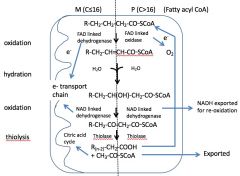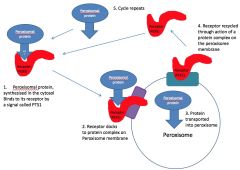![]()
![]()
![]()
Use LEFT and RIGHT arrow keys to navigate between flashcards;
Use UP and DOWN arrow keys to flip the card;
H to show hint;
A reads text to speech;
33 Cards in this Set
- Front
- Back
|
What is the general function of peroxisomes? |
- Many different metabolic activities whichoften depend on the organism in question,the tissue type, developmental stageand even environmental conditions! - Fatty acid degradation and reactiveoxygen metabolism are commonto most peroxisomes Specialised functions; - In plants, part of the pathway of photorespirationis in peroxisomes. - In blood stream trypansomesglycolysis isin peroxisomes. - In the fungus Penicilliumchrysogenumpartof the pathway of penicillin biosynthesis is in peroxisomes. - In other fungi such as Hansenulapolymorpha which can use methanol as a carbonsourceAlcohol oxidase needed for methanol utilisation isa peroxisomalenzyme |
|
|
What tissues have peroxisomes? |
Most prominent in the liver, brain and kidney. |
|
|
What are the metabolic functions of peroxisomes? |
• Longand branched chain fatty acid shortening (α and βoxidation). • EtherLipid (plasmalogen)Biosynthesis. • Bileacid synthesis. • Glyoxylatedetoxification |
|
|
•Longand branched chain fatty acid shortening (α and βoxidation). |
Important for energy metabolism,removing molecules whose build up have toxic effects in the body and metabolismof some fatty acid based signalling molecules |
|
|
• Ether Lipid (plasmalogen) Biosynthesis. |
Plasmalogensaccount for only 0.8% of membrane lipids in liver but 23% in nervous tissue |
|
|
Bile acid synthesis. |
Bile acids aid lipid digestion andthe absorption of the digestion products also lipid soluble vitamins A,D,E& K |
|
|
• Glyoxylate detoxification |
If not further metabolised , glyoxylateis oxidised to oxalate which then precipitates as calcium oxalate resulting inrenal failure. |
|
|
Where does β-oxidationtake place? |
Long, branched fatty acid chains are shortened in the peroxisomes but transported to the mitochondria to be fully degraded. |
|
|
Relationship between peroxisomaland mitochondrial β-oxidation |

|
|
|
What is the core pathway for processing bio active molecules? |
β-oxidation |
|
|
Consequences of peroxisome malfunction? |
Peroxisome biogenesis disorder. Single gene deficiency. |
|
|
What is a biogenesis disorder? |
Deficiency of multiple peroxisomemetabolic pathways due to failure to assemble the organelle. ZellwegerSyndrome spectrum. |
|
|
How can peroxisomes be detected? |
Peroxisomes can be detected in cellsusing targeted fluorescentproteins as reporters or using antibodiesby immunofluorescnce |
|
|
Although peroxisomes are absent, where are the peroxisomal proteins.. |
stay in the cytoplasm |
|
|
Simple model for peroxisomal protein import |

|
|
|
What is defective in the Zellweger syndrome? |
the receptor or components of the dockingor recycling complexesare defective |
|
|
What is the zellweger syndrome spectrum? |
In the most severe cases peroxisomes arecompletely absent or are just empty membrane ‘ghosts’ because genes needed for peroxisomeformation are non functional. If the mutation makes the gene onlypartially functional defective peroxisomes may be formed, hence the patients can showa spectrum of phenotypes. If the mutation makes the gene onlypartially functional defective peroxisomes may be formed, hence the patients can showa spectrum of phenotypes. When the peroxisome isn’t formed or isdefective then the enzymes and proteins that normally function there are partly orwholly mis-localisedto the cytosol. Hence these patients either completelylack or have deficiencies in all peroxisome metabolic pathways |
|
|
What PBDs make the zellweger spectrum |
Zellweger syndrome --> Neonatal adrenoleukodystrophy --> Infantile refsum disease. |
|
|
Symptoms and prognosis of Zellweger syndrome? |
Zellweger syndrome: Facial and cranial abnormalities;weak muscle tone (hypotonia);seizures; inability to feed.Almost every organ system is affected.Babies born with ZS fail to develop and usually die within the first year of life |
|
|
Symptoms and prognosis of Neonatal adrenoleukodystrophy and infantile refsum disease; |
Neonatal adrenoleukodystrophy and Infantile Refsumdisease:Milder forms of ZS, usually because ofsome residual activity of the mutated gene. Most havehypotonia,some have seizures, degeneration of myelin in the CNS can result inneurological deficits. Survival depends on theseverity of the condition. |
|
|
Symptoms and prognosis of RCDP. |
RCDP: Peroxisomes are present but a subset of peroxisomalproteins are missing. Abnormalities of the CNS and profound growth andpsychomotor retardation. Some patients die in the first year of life, others havesurvived to early adulthood |
|
|
What are the diagnosis and treatments of PBDs? |
Diagnosis usually relies on looking atbiochemical pathways affected, for example; •Accumulationof very long chain fatty acids as their breakdown is impaired •Elevatedphytanic/pristanicacid •Reducedplasmalogens •Increasedbile acid intermediates If the defective gene is known thenmolecular testing can be performed and counselling offered to affected families. Since multiple biochemical pathways areaffected a cure isn’t possible at present and treatment is primarily supportive,treating the symptoms. |
|
|
Two examples for disorders of peroxisome function |
X-ALD and PH1 •arisefrom a mutation in a gene that encodes for a specific enzymeactivity within peroxisomes (as opposed to a protein that is needed forassembly of the organelle). |
|
|
What is X-ALD a disorder of? |
•Thisis a disorder of peroxisomal betaoxidation and is the most common of these disorders frequency -1:17,000 males. •Theorder is X linked. Affected boys inherit the affected gene from their mother |
|
|
What is the function of the ABCD1 gene and how is this changed in patients? |
Encodes a membrane protein belonging tothe ATP Binding Cassette family thatTransports very long chain fatty acidsinto the peroxisome. In patients very long chain fatty acids(C24-C26 and longer) accumulate and thisis used for diagnosis. |
|
|
Disease symptoms of X-ALD |
There are different forms of X-ALD andthere isn’t a strong correlation between the causal mutation and the clinicalpresentation.. Most frequent presentations are:Childhood Cerebral ALD (CCALD) and Adrenomyeloneuroathy(AMN) CCALD manifests at 3-10 years of age. There is inflammatory demyelination ofneurones in the brain and progressivedeterioration leading todisability and death within 3 years. AMN is later onset (late 20’s normally)and slower progressing. Symptoms include muscleweakness and often impaired adrenocorticalfunction. Some patients may havebrain involvement. |
|
|
What are the treatment and therapies for X-ALD? |
Many patients have impaired steroidhormone synthesis due to toxic effects of the longchain fatty acids on the adrenalglands so adrenal hormone therapy given. Fats in the diet are restricted. Bone marrow transplants have beensuccessful in slowing or halting progression of the cerebral form of ALD but is a highrisk treatment as in some patients it can cause the disease to progress more rapidly. Gene therapy is also being explored as atreatment and shows promise but the long term prognosis is unclear as this is avery recent experimental treatment |
|
|
Example of a single gene disorders? |
Primary hyperoxaluriatype 1 (PH1) |
|
|
What is PH1 |
Primary hyperoxaluriatype 1 (PH1) is an autosomal recessive condition caused bydefects in Alanine GlyoxylateAmino Transferase,a peroxisomalliver enzyme. Frequency varies between populations 1 in100,000- 1 in a million. -AGT converts glyoxylateto glycine. - If glyoxylateaccumulates as a result of AGT deficiency oxalate builds up. - Oxalate binds Ca2+ ionsand precipitates, leading to kidney stones and renalfailure. |
|
|
What can PH1 caused by? |
Most PH1 suffers lack the AGT enzymecompletely however a subset have most orall of the enzyme mislocalised in mitochondria. P11L mutation creates a mitochondrialtargeting signal, while G170R creates a protein conformation that is more readilyimported by mitochondria. Because glyoxylateis produced in peroxisomes if the active AGT is in mitochondriathe substrate and enzyme areseparated by 3 membranes and never come together. |
|
|
What are the treatments and therapies? |
50% of PH1 patients suffer renal failureby age 15, 80% by age 30. High doses of vitamin B6 can normalise oxalate levels insome patients. Patients are advised to avoid foods withhigh levels of oxalate (e.g. rhubarb, chocolate)and to drink plenty of water. Since AGT is a liver enzyme a livertransplant provides active and correctly localised AGTenzyme.. If the kidneys have already been damageda kidney transplant is required as well. |
|
|
Peroxisomes, fungi and plant disease.. |
In some plant pathogenic fungi such asrice blast fungus (Magnaporthe oryzae) andAnthracnose fungi (Colletotrichum spp.)peroxisomes are essential for pathogenicity. Infection requires formation ofspecialised structures, appressoriawhich have thick melanised walls. Peroxisomalbeta-oxidation of lipids provide energy, osmolitesfor the development of turgor pressure and precursors formelanin production |
|
|
Summary |
•Peroxisomesare organelles with diverse but important functions found in essentially alleukaryotes •β-oxidationis a core conserved metabolic pathway of peroxisomes that is important in both degradativeand biosynthetic pathways •Peroxisomebiogenesis disorders (ZellwegerSyndrome spectrum) are severe multisystem disorders causedbythe failureto assemble peroxisomes properly and the loss of multiplemetabolic pathways •Xlinked adrenoleukodystrophyis a single gene defect that affects peroxisomalβoxidation,causes accumulation of very longchain fatty acids and can result in demyelination ofneurones and serious neurologicalsymptoms. •Primaryhyperoxaluriatype 1 is caused by deficiency of peroxisomalAlanine GlyoxylateAmino Transferasein liver. The consequence isformation of high levels of calcium oxalateleading to renal failure. •Peroxisomemetabolic pathways are also important in pathogenicity of some plant pathogenic fungi |

